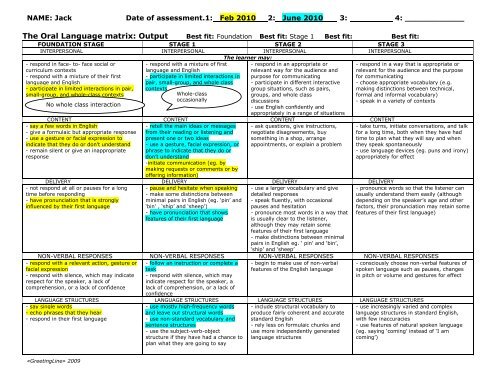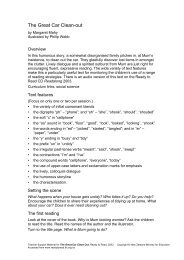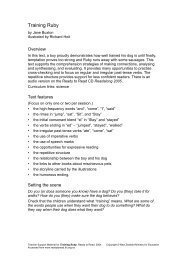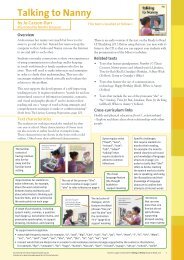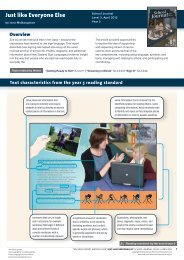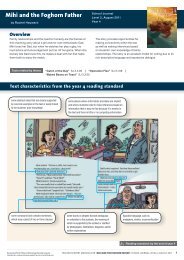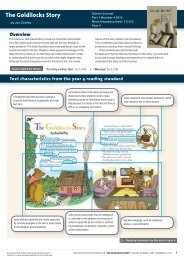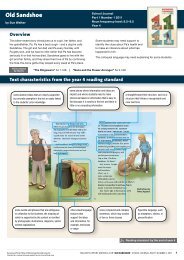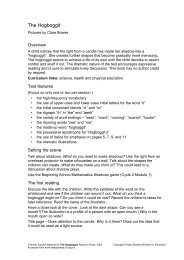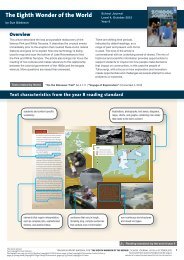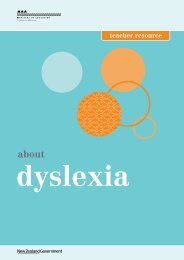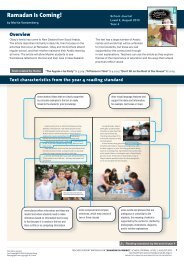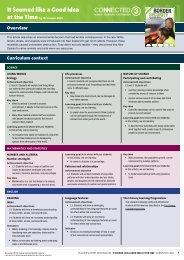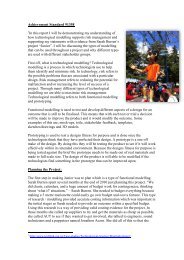The Oral Language Matrix: Output Dates: 1st ... - Literacy Online
The Oral Language Matrix: Output Dates: 1st ... - Literacy Online
The Oral Language Matrix: Output Dates: 1st ... - Literacy Online
You also want an ePaper? Increase the reach of your titles
YUMPU automatically turns print PDFs into web optimized ePapers that Google loves.
NAME: Jack Date of assessment.1: Feb 2010 2: June 2010 3: 4: ____________<strong>The</strong> <strong>Oral</strong> <strong>Language</strong> matrix: <strong>Output</strong> Best fit: Foundation Best fit: Stage 1 Best fit: Best fit:FOUNDATION STAGE STAGE 1 STAGE 2 STAGE 3INTERPERSONAL INTERPERSONAL INTERPERSONAL INTERPERSONAL- respond in face- to- face social orcurriculum contexts- respond with a mixture of their firstlanguage and English- participate in limited interactions in pair,small-group, and whole-class contextsNo whole class interaction- respond with a mixture of firstlanguage and English- participate in limited interactions inpair, small-group, and whole classcontextsWhole-classoccasionally<strong>The</strong> learner may:- respond in an appropriate orrelevant way for the audience andpurpose for communicating- participate in different interactivegroup situations, such as pairs,groups, and whole classdiscussions- use English confidently andappropriately in a range of situationsCONTENT CONTENT CONTENT CONTENT- say a few words in English- give a formulaic but appropriate response- use a gesture or facial expression toindicate that they do or don’t understand- remain silent or give an inappropriateresponse- ask questions, give instructions,negotiate disagreements, buysomething in a shop, arrangeappointments, or explain a problem- retell the main ideas or messagesfrom their reading or listening andpresent one or two ideas- use a gesture, facial expression, orphrase to indicate that they do ordon’t understand-initiate communication (eg. bymaking requests or comments or byoffering information)DELIVERY DELIVERY DELIVERY DELIVERY- not respond at all or pauses for a longtime before responding- have pronunciation that is stronglyinfluenced by their first language- respond in a way that is appropriate orrelevant for the audience and the purposefor communicating- choose appropriate vocabulary (e.g.making distinctions between technical,formal and informal vocabulary)- speak in a variety of contexts- take turns, initiate conversations, and talkfor a long time, both when they have hadtime to plan what they will say and whenthey speak spontaneously- use language devices (eg. puns and irony)appropriately for effect- pause and hesitate when speaking- make some distinctions betweenminimal pairs in English (eg. ‘pin’ and‘bin’ , ‘ship’ and ‘sheep’)- have pronunciation that showsfeatures of their first language- use a larger vocabulary and givedetailed responses- speak fluently, with occasionalpauses and hesitation- pronounce most words in a way thatis usually clear to the listener,although they may retain somefeatures of their first language- make distinctions between minimalpairs in English eg. ‘ pin’ and ‘bin’,‘ship’ and ‘sheep’NON-VERBAL RESPONSES NON-VERBAL RESPONSES NON-VERBAL RESPONSES NON-VERBAL RESPONSES- respond with a relevant action, gesture orfacial expression- respond with silence, which may indicaterespect for the speaker, a lack ofcomprehension, or a lack of confidence- follow an instruction or complete atask- respond with silence, which mayindicate respect for the speaker, alack of comprehension, or a lack ofconfidence- begin to make use of non-verbalfeatures of the English language- pronounce words so that the listener canusually understand them easily (althoughdepending on the speaker’s age and otherfactors, their pronunciation may retain somefeatures of their first language)- consciously choose non-verbal features ofspoken language such as pauses, changesin pitch or volume and gestures for effectLANGUAGE STRUCTURES LANGUAGE STRUCTURES LANGUAGE STRUCTURES LANGUAGE STRUCTURES- say single words- echo phrases that they hear- respond in their first language- use mostly high-frequency wordsand leave out structural words- use non-standard vocabulary andsentence structures- use the subject-verb-objectstructure if they have had a chance toplan what they are going to say- include structural vocabulary toproduce fairly coherent and accuratestandard English- rely less on formulaic chunks anduse more independently generatedlanguage structures- use increasingly varied and complexlanguage structures in standard English,with few inaccuracies- use features of natural spoken language(eg. saying ‘coming’ instead of ‘I amcoming’)«GreetingLine» 2009
«GreetingLine» 2009


